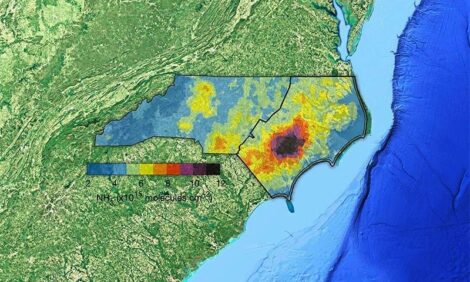



Cranial-ventral Consolidated Lung in a Healthy Coughing Pig: Isn't That M. hyo.?
By Tim Blackwell - Animal Health and Welfare/ OMAFRA; Murray Hazlett - Animal Health Laboratory/University of Guelph.The more you learn, the less you know. This is particularly true with swine diagnostics in 2007. New diseases and new diagnostic technologies are combining to make accurate diagnoses ever more challenging. Four recently weaned pigs that were coughing were sent to the Animal Health Laboratory at the University of Guelph to determine the cause of the cough. All four pigs were below average weight for their age and had similar lesions. Figure 1 is a photograph of the lungs of one of the four pigs.
 Figure 1 - A photograph of the lungs of one of the four pigs Figure 1 - A photograph of the lungs of one of the four pigs |
The photograph shows a typical pattern of cranial-ventral consolidation that is commonly associated with Mycoplasma hyopneumoniae infection in swine (area in photo that is circled). M. hyopneumoniae colonizes the bronchi and bronchioles, causing inflammation and subsequent blockage of many of the infected airways with inflammatory debris. Once the airway is blocked, air trapped in alveoli is reabsorbed and the affected section of lung collapses. This creates the plum-coloured, dense lung tissue commonly associated with M. hyopneumoniae infection.
The four pigs submitted for postmortem examination were from a M. hyopeumoniae-free herd that is regularly monitored for the presence of M. hyopneumoniae antibodies. All four pigs sent for postmortem were PCR negative for M. hyopneumoniae and the herd has remained sero-negative for antibodies against M. hyopneumoniae. Swine influenza virus was considered a possible cause of the bronchiolitis and cough but lung tissues were also PCR negative for swine influenza. Streptococcus suis and Haemophilus parasuis were isolated from the lungs of these pigs.
The final histologic diagnosis was neutrophilic bronchiolitis and pneumonitis, with a suggestion of PCV2 (Porcine Circovirus 2) infection in some lymph nodes and lung sections. The bacterial isolates were considered to be secondary pathogens in a pneumonia of this sort. This is particularly true when multiple pigs are affected and the initiating cause of the bronchiolitis is undetermined. Influenza virus could have initiated the bronchiolitis if the virus was eliminated from the pigs by the time the four pigs were sent for postmortem.
If the lesions in Figure 1 were found during an on-farm postmortem examination of poor-doing, coughing pigs in a M. hyopneumoniae positive herd, it would be easy to justify treatment or preventive measures for M. hyopneumoniae infection. Only laboratory confirmation, however, can assure the veterinarian that the obvious diagnosis is the correct one.
March 2007






